Intellectual Property and Protection in Wearable Tech Industry
VerifiedAdded on 2020/05/16
|11
|2551
|441
Report
AI Summary
This report delves into the critical aspects of intellectual property (IP) protection, particularly within the technology-driven wearable tech industries and software development. It emphasizes the importance of IP rights, including copyrights, patents, trademarks, and trade secrets, as vital assets for business success. The report outlines various methods for IP protection, such as copyright for software code and design, and patents for both the functionality and design aspects of software. It highlights the significance of strong security practices, encryption, and detailed documentation to safeguard IP. Furthermore, it discusses the value of expert opinions and the importance of user experience and speed in commercialization for effective IP protection. The report also differentiates between provisional and non-provisional patents and explores the practical consequences of patenting strategies, especially within the pharmaceutical and small-scale enterprise sectors. Overall, the report provides a comprehensive overview of IP protection strategies, offering valuable insights for businesses and individuals aiming to secure their intellectual assets.
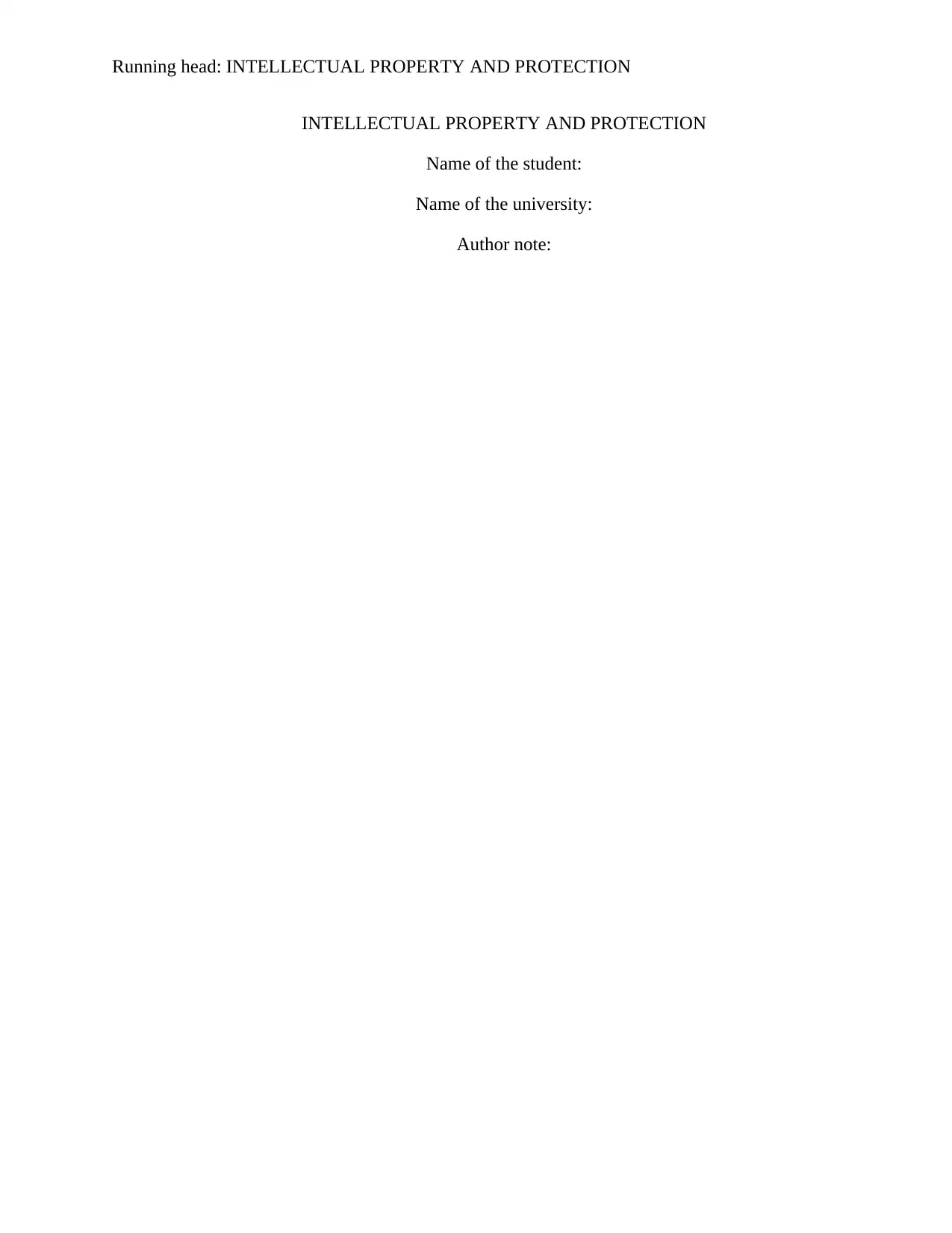
Running head: INTELLECTUAL PROPERTY AND PROTECTION
INTELLECTUAL PROPERTY AND PROTECTION
Name of the student:
Name of the university:
Author note:
INTELLECTUAL PROPERTY AND PROTECTION
Name of the student:
Name of the university:
Author note:
Paraphrase This Document
Need a fresh take? Get an instant paraphrase of this document with our AI Paraphraser
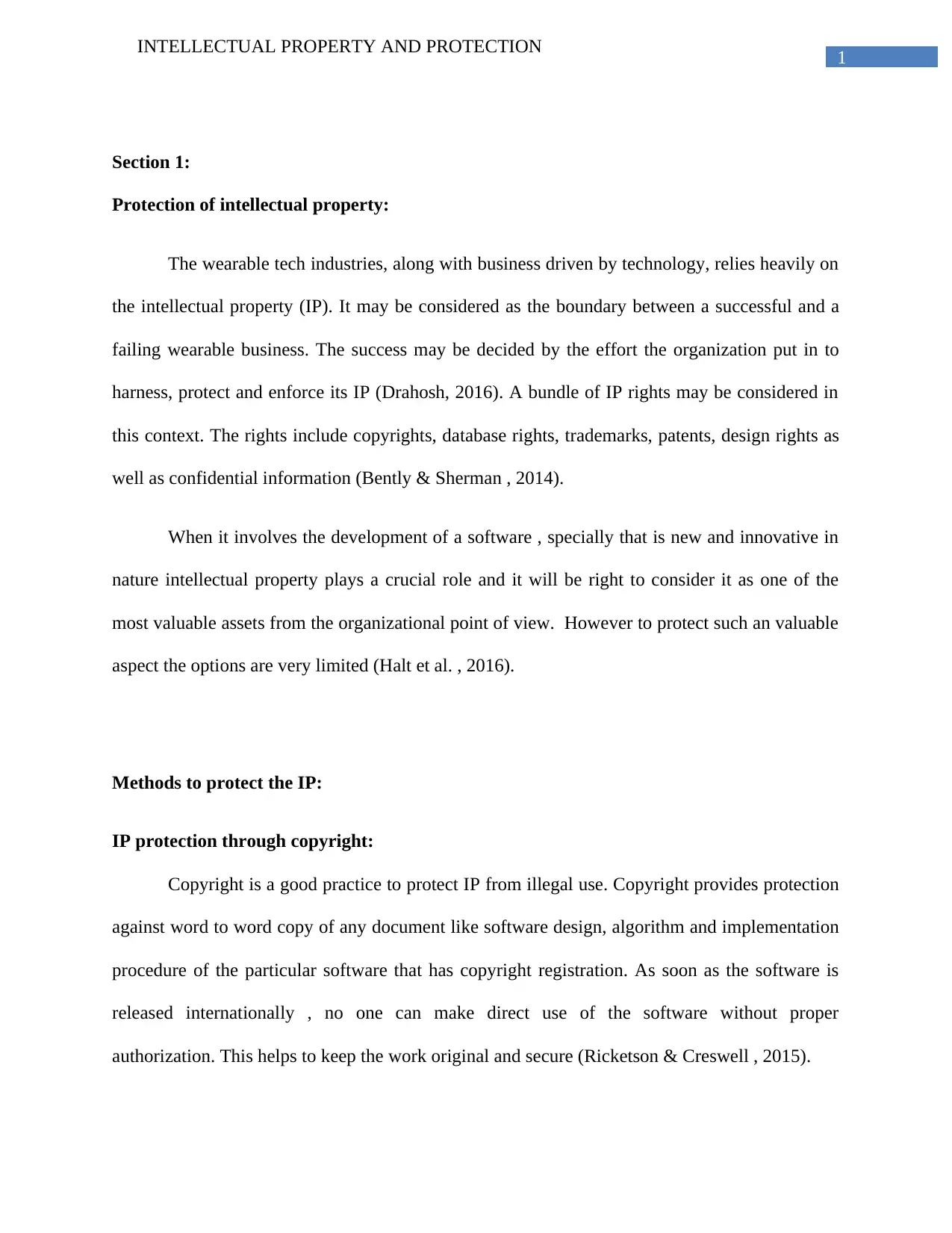
1
INTELLECTUAL PROPERTY AND PROTECTION
Section 1:
Protection of intellectual property:
The wearable tech industries, along with business driven by technology, relies heavily on
the intellectual property (IP). It may be considered as the boundary between a successful and a
failing wearable business. The success may be decided by the effort the organization put in to
harness, protect and enforce its IP (Drahosh, 2016). A bundle of IP rights may be considered in
this context. The rights include copyrights, database rights, trademarks, patents, design rights as
well as confidential information (Bently & Sherman , 2014).
When it involves the development of a software , specially that is new and innovative in
nature intellectual property plays a crucial role and it will be right to consider it as one of the
most valuable assets from the organizational point of view. However to protect such an valuable
aspect the options are very limited (Halt et al. , 2016).
Methods to protect the IP:
IP protection through copyright:
Copyright is a good practice to protect IP from illegal use. Copyright provides protection
against word to word copy of any document like software design, algorithm and implementation
procedure of the particular software that has copyright registration. As soon as the software is
released internationally , no one can make direct use of the software without proper
authorization. This helps to keep the work original and secure (Ricketson & Creswell , 2015).
INTELLECTUAL PROPERTY AND PROTECTION
Section 1:
Protection of intellectual property:
The wearable tech industries, along with business driven by technology, relies heavily on
the intellectual property (IP). It may be considered as the boundary between a successful and a
failing wearable business. The success may be decided by the effort the organization put in to
harness, protect and enforce its IP (Drahosh, 2016). A bundle of IP rights may be considered in
this context. The rights include copyrights, database rights, trademarks, patents, design rights as
well as confidential information (Bently & Sherman , 2014).
When it involves the development of a software , specially that is new and innovative in
nature intellectual property plays a crucial role and it will be right to consider it as one of the
most valuable assets from the organizational point of view. However to protect such an valuable
aspect the options are very limited (Halt et al. , 2016).
Methods to protect the IP:
IP protection through copyright:
Copyright is a good practice to protect IP from illegal use. Copyright provides protection
against word to word copy of any document like software design, algorithm and implementation
procedure of the particular software that has copyright registration. As soon as the software is
released internationally , no one can make direct use of the software without proper
authorization. This helps to keep the work original and secure (Ricketson & Creswell , 2015).
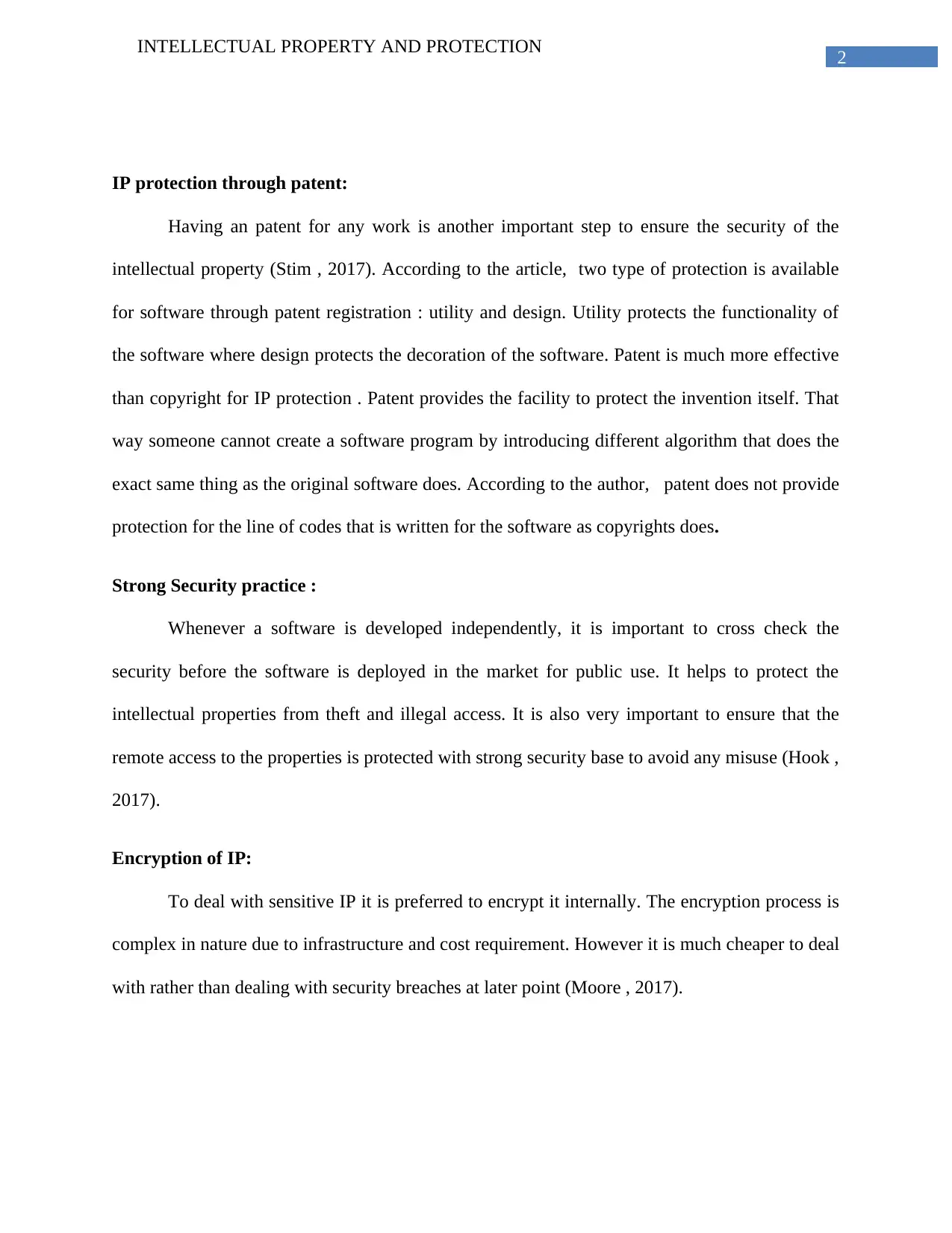
2
INTELLECTUAL PROPERTY AND PROTECTION
IP protection through patent:
Having an patent for any work is another important step to ensure the security of the
intellectual property (Stim , 2017). According to the article, two type of protection is available
for software through patent registration : utility and design. Utility protects the functionality of
the software where design protects the decoration of the software. Patent is much more effective
than copyright for IP protection . Patent provides the facility to protect the invention itself. That
way someone cannot create a software program by introducing different algorithm that does the
exact same thing as the original software does. According to the author, patent does not provide
protection for the line of codes that is written for the software as copyrights does.
Strong Security practice :
Whenever a software is developed independently, it is important to cross check the
security before the software is deployed in the market for public use. It helps to protect the
intellectual properties from theft and illegal access. It is also very important to ensure that the
remote access to the properties is protected with strong security base to avoid any misuse (Hook ,
2017).
Encryption of IP:
To deal with sensitive IP it is preferred to encrypt it internally. The encryption process is
complex in nature due to infrastructure and cost requirement. However it is much cheaper to deal
with rather than dealing with security breaches at later point (Moore , 2017).
INTELLECTUAL PROPERTY AND PROTECTION
IP protection through patent:
Having an patent for any work is another important step to ensure the security of the
intellectual property (Stim , 2017). According to the article, two type of protection is available
for software through patent registration : utility and design. Utility protects the functionality of
the software where design protects the decoration of the software. Patent is much more effective
than copyright for IP protection . Patent provides the facility to protect the invention itself. That
way someone cannot create a software program by introducing different algorithm that does the
exact same thing as the original software does. According to the author, patent does not provide
protection for the line of codes that is written for the software as copyrights does.
Strong Security practice :
Whenever a software is developed independently, it is important to cross check the
security before the software is deployed in the market for public use. It helps to protect the
intellectual properties from theft and illegal access. It is also very important to ensure that the
remote access to the properties is protected with strong security base to avoid any misuse (Hook ,
2017).
Encryption of IP:
To deal with sensitive IP it is preferred to encrypt it internally. The encryption process is
complex in nature due to infrastructure and cost requirement. However it is much cheaper to deal
with rather than dealing with security breaches at later point (Moore , 2017).
⊘ This is a preview!⊘
Do you want full access?
Subscribe today to unlock all pages.

Trusted by 1+ million students worldwide
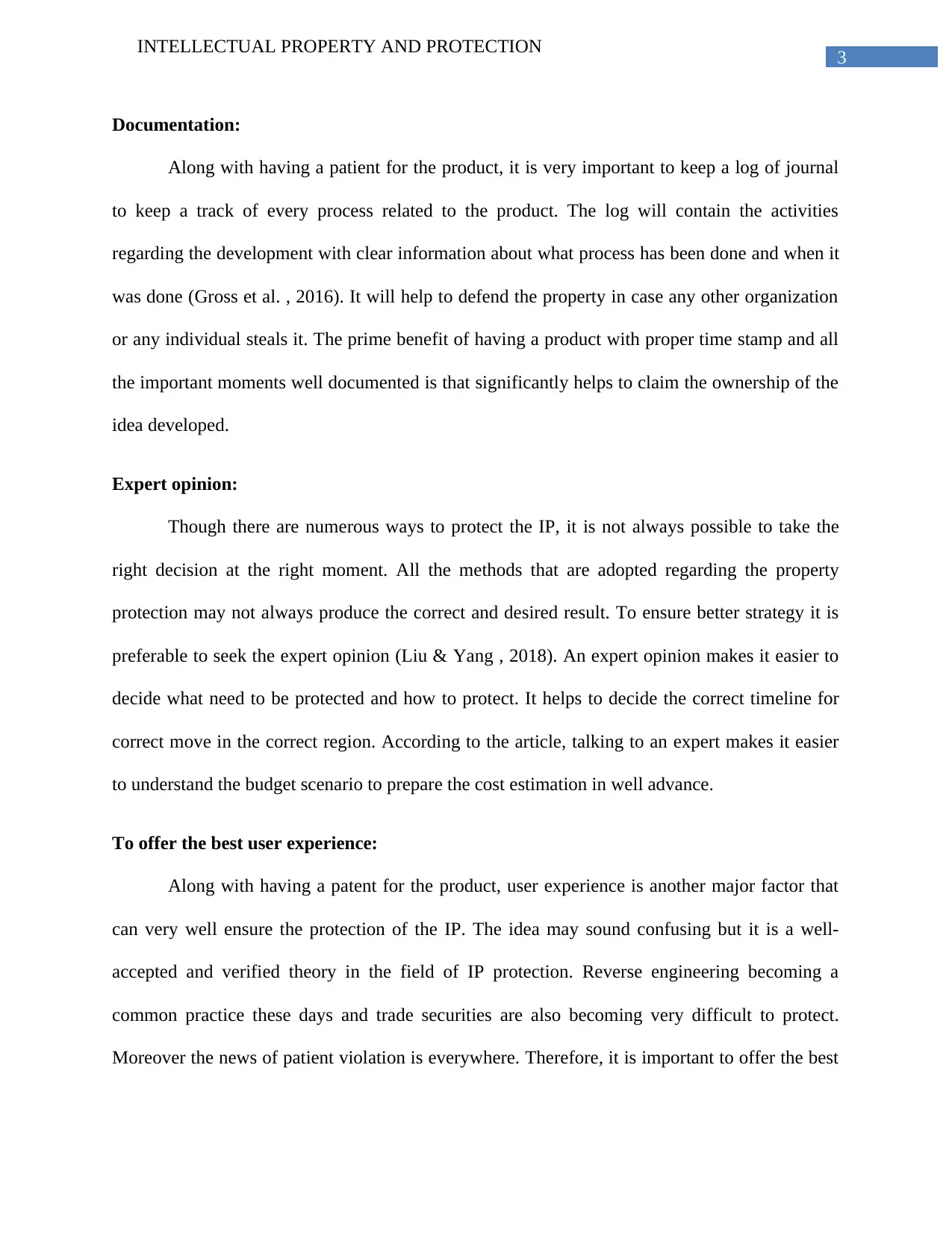
3
INTELLECTUAL PROPERTY AND PROTECTION
Documentation:
Along with having a patient for the product, it is very important to keep a log of journal
to keep a track of every process related to the product. The log will contain the activities
regarding the development with clear information about what process has been done and when it
was done (Gross et al. , 2016). It will help to defend the property in case any other organization
or any individual steals it. The prime benefit of having a product with proper time stamp and all
the important moments well documented is that significantly helps to claim the ownership of the
idea developed.
Expert opinion:
Though there are numerous ways to protect the IP, it is not always possible to take the
right decision at the right moment. All the methods that are adopted regarding the property
protection may not always produce the correct and desired result. To ensure better strategy it is
preferable to seek the expert opinion (Liu & Yang , 2018). An expert opinion makes it easier to
decide what need to be protected and how to protect. It helps to decide the correct timeline for
correct move in the correct region. According to the article, talking to an expert makes it easier
to understand the budget scenario to prepare the cost estimation in well advance.
To offer the best user experience:
Along with having a patent for the product, user experience is another major factor that
can very well ensure the protection of the IP. The idea may sound confusing but it is a well-
accepted and verified theory in the field of IP protection. Reverse engineering becoming a
common practice these days and trade securities are also becoming very difficult to protect.
Moreover the news of patient violation is everywhere. Therefore, it is important to offer the best
INTELLECTUAL PROPERTY AND PROTECTION
Documentation:
Along with having a patient for the product, it is very important to keep a log of journal
to keep a track of every process related to the product. The log will contain the activities
regarding the development with clear information about what process has been done and when it
was done (Gross et al. , 2016). It will help to defend the property in case any other organization
or any individual steals it. The prime benefit of having a product with proper time stamp and all
the important moments well documented is that significantly helps to claim the ownership of the
idea developed.
Expert opinion:
Though there are numerous ways to protect the IP, it is not always possible to take the
right decision at the right moment. All the methods that are adopted regarding the property
protection may not always produce the correct and desired result. To ensure better strategy it is
preferable to seek the expert opinion (Liu & Yang , 2018). An expert opinion makes it easier to
decide what need to be protected and how to protect. It helps to decide the correct timeline for
correct move in the correct region. According to the article, talking to an expert makes it easier
to understand the budget scenario to prepare the cost estimation in well advance.
To offer the best user experience:
Along with having a patent for the product, user experience is another major factor that
can very well ensure the protection of the IP. The idea may sound confusing but it is a well-
accepted and verified theory in the field of IP protection. Reverse engineering becoming a
common practice these days and trade securities are also becoming very difficult to protect.
Moreover the news of patient violation is everywhere. Therefore, it is important to offer the best
Paraphrase This Document
Need a fresh take? Get an instant paraphrase of this document with our AI Paraphraser
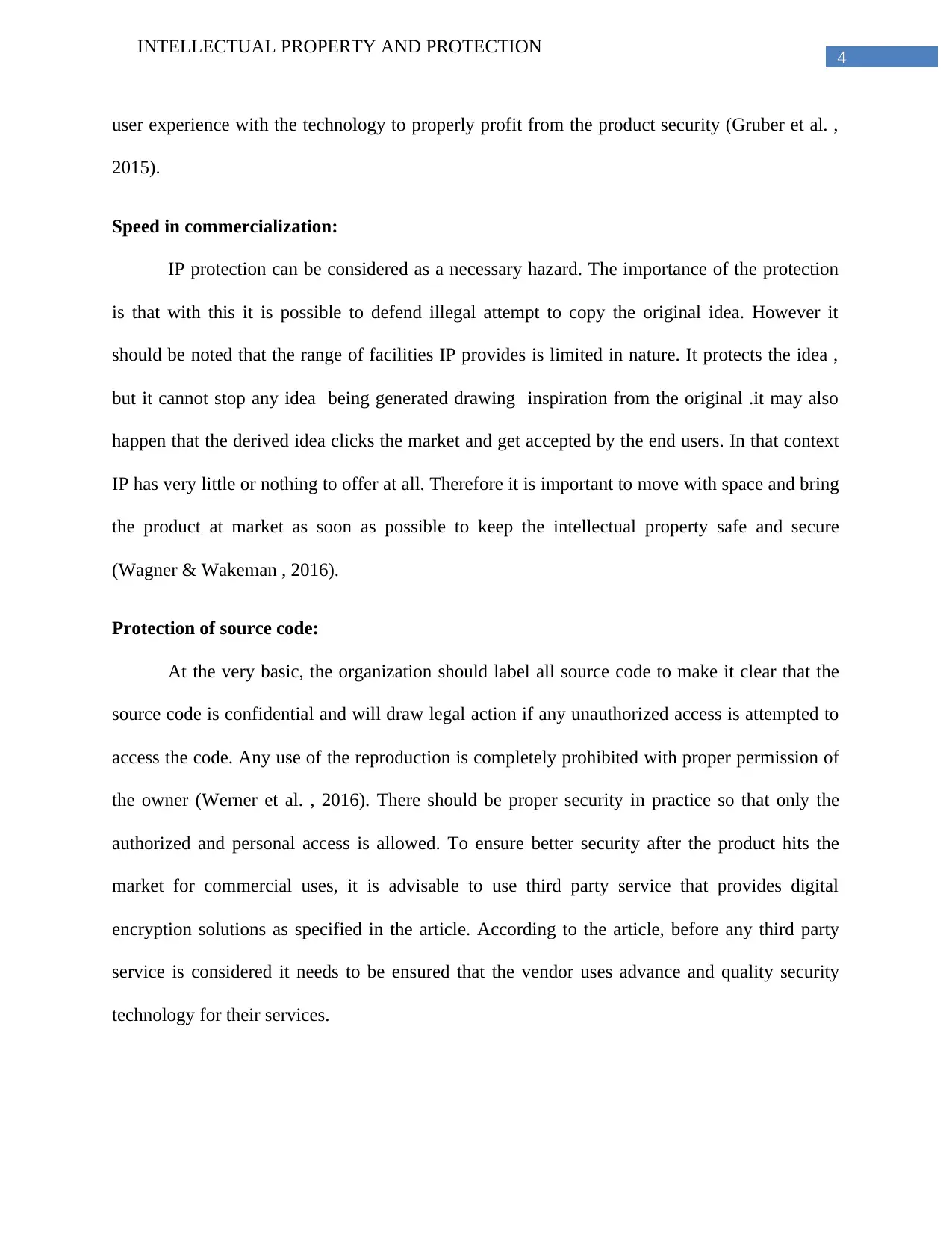
4
INTELLECTUAL PROPERTY AND PROTECTION
user experience with the technology to properly profit from the product security (Gruber et al. ,
2015).
Speed in commercialization:
IP protection can be considered as a necessary hazard. The importance of the protection
is that with this it is possible to defend illegal attempt to copy the original idea. However it
should be noted that the range of facilities IP provides is limited in nature. It protects the idea ,
but it cannot stop any idea being generated drawing inspiration from the original .it may also
happen that the derived idea clicks the market and get accepted by the end users. In that context
IP has very little or nothing to offer at all. Therefore it is important to move with space and bring
the product at market as soon as possible to keep the intellectual property safe and secure
(Wagner & Wakeman , 2016).
Protection of source code:
At the very basic, the organization should label all source code to make it clear that the
source code is confidential and will draw legal action if any unauthorized access is attempted to
access the code. Any use of the reproduction is completely prohibited with proper permission of
the owner (Werner et al. , 2016). There should be proper security in practice so that only the
authorized and personal access is allowed. To ensure better security after the product hits the
market for commercial uses, it is advisable to use third party service that provides digital
encryption solutions as specified in the article. According to the article, before any third party
service is considered it needs to be ensured that the vendor uses advance and quality security
technology for their services.
INTELLECTUAL PROPERTY AND PROTECTION
user experience with the technology to properly profit from the product security (Gruber et al. ,
2015).
Speed in commercialization:
IP protection can be considered as a necessary hazard. The importance of the protection
is that with this it is possible to defend illegal attempt to copy the original idea. However it
should be noted that the range of facilities IP provides is limited in nature. It protects the idea ,
but it cannot stop any idea being generated drawing inspiration from the original .it may also
happen that the derived idea clicks the market and get accepted by the end users. In that context
IP has very little or nothing to offer at all. Therefore it is important to move with space and bring
the product at market as soon as possible to keep the intellectual property safe and secure
(Wagner & Wakeman , 2016).
Protection of source code:
At the very basic, the organization should label all source code to make it clear that the
source code is confidential and will draw legal action if any unauthorized access is attempted to
access the code. Any use of the reproduction is completely prohibited with proper permission of
the owner (Werner et al. , 2016). There should be proper security in practice so that only the
authorized and personal access is allowed. To ensure better security after the product hits the
market for commercial uses, it is advisable to use third party service that provides digital
encryption solutions as specified in the article. According to the article, before any third party
service is considered it needs to be ensured that the vendor uses advance and quality security
technology for their services.
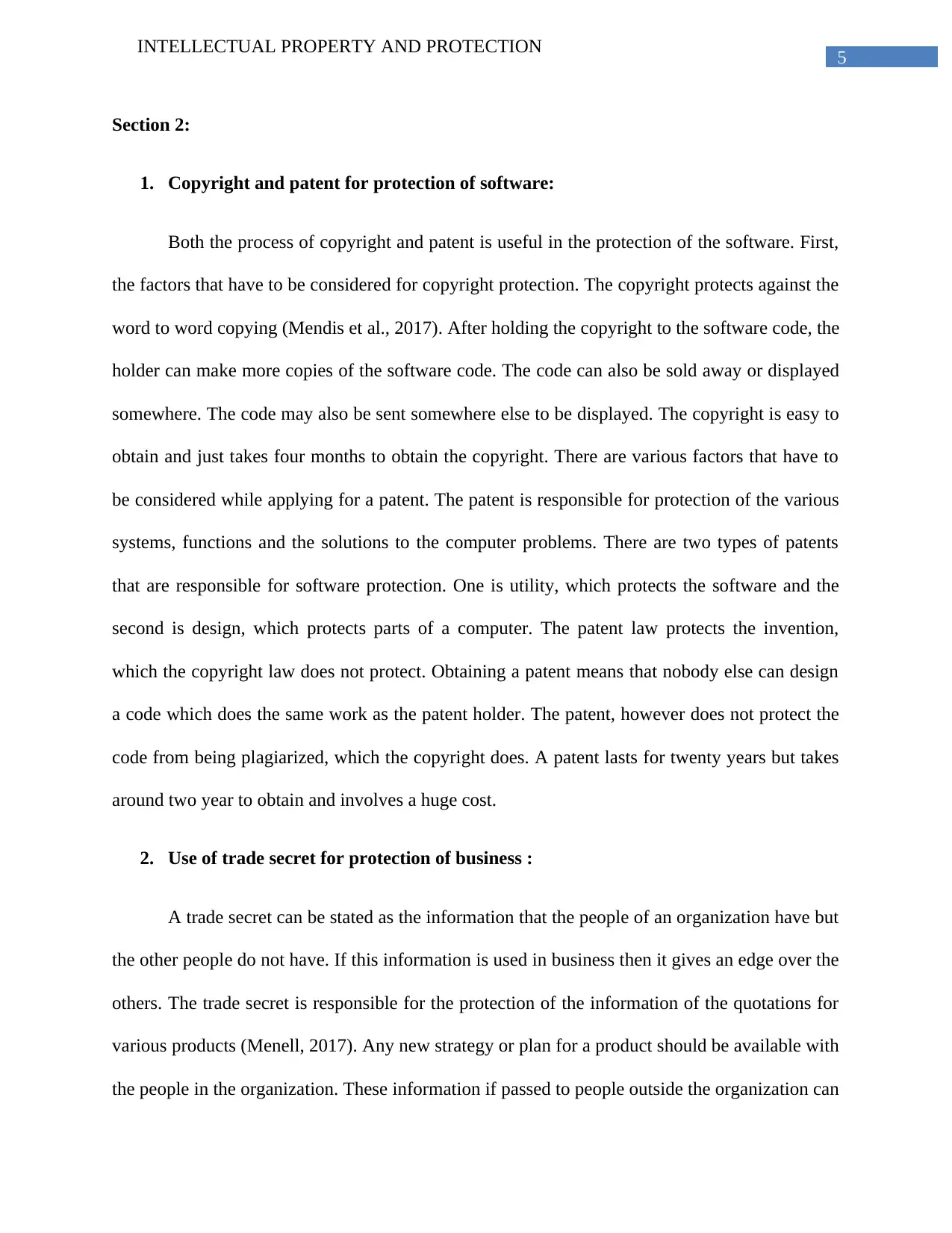
5
INTELLECTUAL PROPERTY AND PROTECTION
Section 2:
1. Copyright and patent for protection of software:
Both the process of copyright and patent is useful in the protection of the software. First,
the factors that have to be considered for copyright protection. The copyright protects against the
word to word copying (Mendis et al., 2017). After holding the copyright to the software code, the
holder can make more copies of the software code. The code can also be sold away or displayed
somewhere. The code may also be sent somewhere else to be displayed. The copyright is easy to
obtain and just takes four months to obtain the copyright. There are various factors that have to
be considered while applying for a patent. The patent is responsible for protection of the various
systems, functions and the solutions to the computer problems. There are two types of patents
that are responsible for software protection. One is utility, which protects the software and the
second is design, which protects parts of a computer. The patent law protects the invention,
which the copyright law does not protect. Obtaining a patent means that nobody else can design
a code which does the same work as the patent holder. The patent, however does not protect the
code from being plagiarized, which the copyright does. A patent lasts for twenty years but takes
around two year to obtain and involves a huge cost.
2. Use of trade secret for protection of business :
A trade secret can be stated as the information that the people of an organization have but
the other people do not have. If this information is used in business then it gives an edge over the
others. The trade secret is responsible for the protection of the information of the quotations for
various products (Menell, 2017). Any new strategy or plan for a product should be available with
the people in the organization. These information if passed to people outside the organization can
INTELLECTUAL PROPERTY AND PROTECTION
Section 2:
1. Copyright and patent for protection of software:
Both the process of copyright and patent is useful in the protection of the software. First,
the factors that have to be considered for copyright protection. The copyright protects against the
word to word copying (Mendis et al., 2017). After holding the copyright to the software code, the
holder can make more copies of the software code. The code can also be sold away or displayed
somewhere. The code may also be sent somewhere else to be displayed. The copyright is easy to
obtain and just takes four months to obtain the copyright. There are various factors that have to
be considered while applying for a patent. The patent is responsible for protection of the various
systems, functions and the solutions to the computer problems. There are two types of patents
that are responsible for software protection. One is utility, which protects the software and the
second is design, which protects parts of a computer. The patent law protects the invention,
which the copyright law does not protect. Obtaining a patent means that nobody else can design
a code which does the same work as the patent holder. The patent, however does not protect the
code from being plagiarized, which the copyright does. A patent lasts for twenty years but takes
around two year to obtain and involves a huge cost.
2. Use of trade secret for protection of business :
A trade secret can be stated as the information that the people of an organization have but
the other people do not have. If this information is used in business then it gives an edge over the
others. The trade secret is responsible for the protection of the information of the quotations for
various products (Menell, 2017). Any new strategy or plan for a product should be available with
the people in the organization. These information if passed to people outside the organization can
⊘ This is a preview!⊘
Do you want full access?
Subscribe today to unlock all pages.

Trusted by 1+ million students worldwide
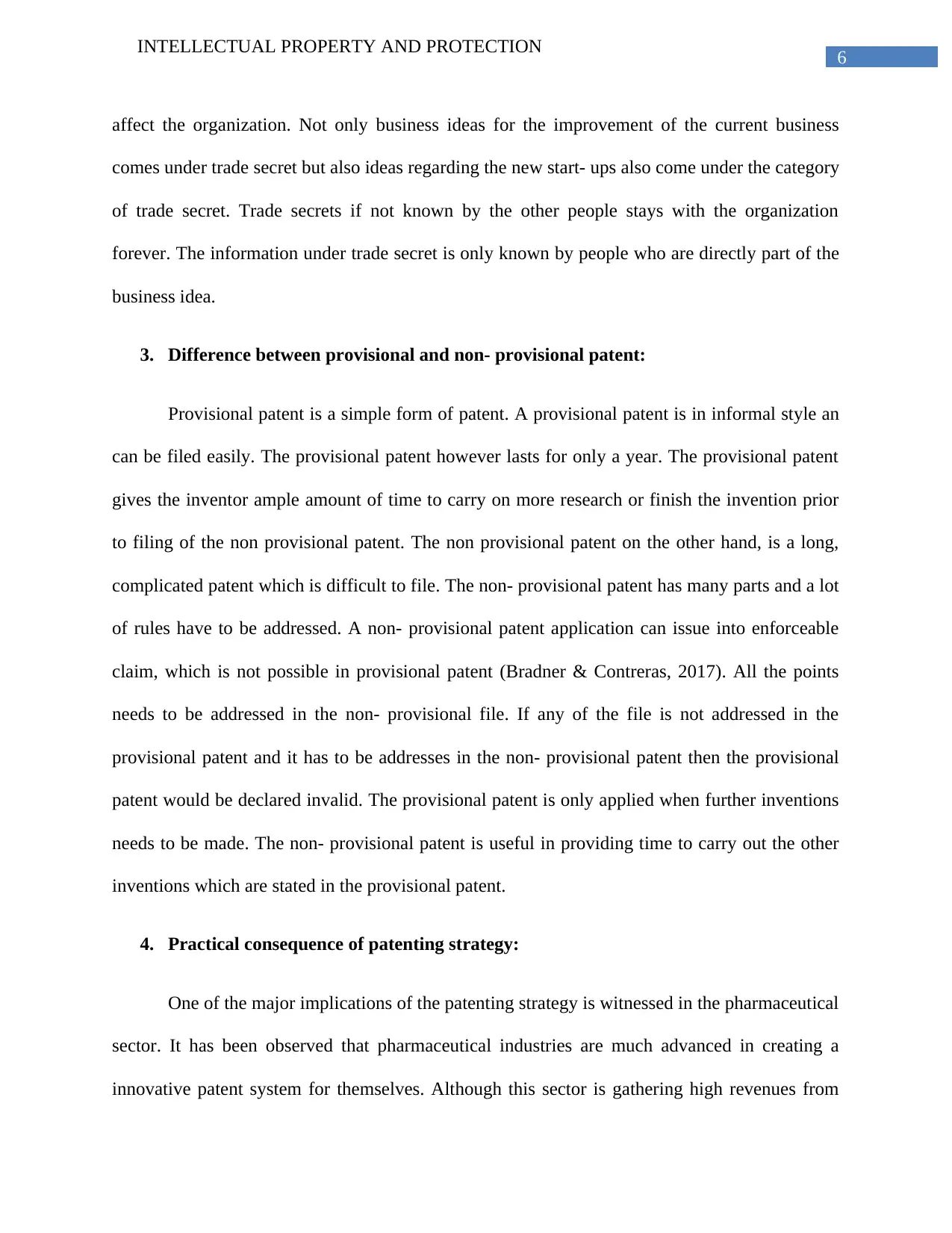
6
INTELLECTUAL PROPERTY AND PROTECTION
affect the organization. Not only business ideas for the improvement of the current business
comes under trade secret but also ideas regarding the new start- ups also come under the category
of trade secret. Trade secrets if not known by the other people stays with the organization
forever. The information under trade secret is only known by people who are directly part of the
business idea.
3. Difference between provisional and non- provisional patent:
Provisional patent is a simple form of patent. A provisional patent is in informal style an
can be filed easily. The provisional patent however lasts for only a year. The provisional patent
gives the inventor ample amount of time to carry on more research or finish the invention prior
to filing of the non provisional patent. The non provisional patent on the other hand, is a long,
complicated patent which is difficult to file. The non- provisional patent has many parts and a lot
of rules have to be addressed. A non- provisional patent application can issue into enforceable
claim, which is not possible in provisional patent (Bradner & Contreras, 2017). All the points
needs to be addressed in the non- provisional file. If any of the file is not addressed in the
provisional patent and it has to be addresses in the non- provisional patent then the provisional
patent would be declared invalid. The provisional patent is only applied when further inventions
needs to be made. The non- provisional patent is useful in providing time to carry out the other
inventions which are stated in the provisional patent.
4. Practical consequence of patenting strategy:
One of the major implications of the patenting strategy is witnessed in the pharmaceutical
sector. It has been observed that pharmaceutical industries are much advanced in creating a
innovative patent system for themselves. Although this sector is gathering high revenues from
INTELLECTUAL PROPERTY AND PROTECTION
affect the organization. Not only business ideas for the improvement of the current business
comes under trade secret but also ideas regarding the new start- ups also come under the category
of trade secret. Trade secrets if not known by the other people stays with the organization
forever. The information under trade secret is only known by people who are directly part of the
business idea.
3. Difference between provisional and non- provisional patent:
Provisional patent is a simple form of patent. A provisional patent is in informal style an
can be filed easily. The provisional patent however lasts for only a year. The provisional patent
gives the inventor ample amount of time to carry on more research or finish the invention prior
to filing of the non provisional patent. The non provisional patent on the other hand, is a long,
complicated patent which is difficult to file. The non- provisional patent has many parts and a lot
of rules have to be addressed. A non- provisional patent application can issue into enforceable
claim, which is not possible in provisional patent (Bradner & Contreras, 2017). All the points
needs to be addressed in the non- provisional file. If any of the file is not addressed in the
provisional patent and it has to be addresses in the non- provisional patent then the provisional
patent would be declared invalid. The provisional patent is only applied when further inventions
needs to be made. The non- provisional patent is useful in providing time to carry out the other
inventions which are stated in the provisional patent.
4. Practical consequence of patenting strategy:
One of the major implications of the patenting strategy is witnessed in the pharmaceutical
sector. It has been observed that pharmaceutical industries are much advanced in creating a
innovative patent system for themselves. Although this sector is gathering high revenues from
Paraphrase This Document
Need a fresh take? Get an instant paraphrase of this document with our AI Paraphraser
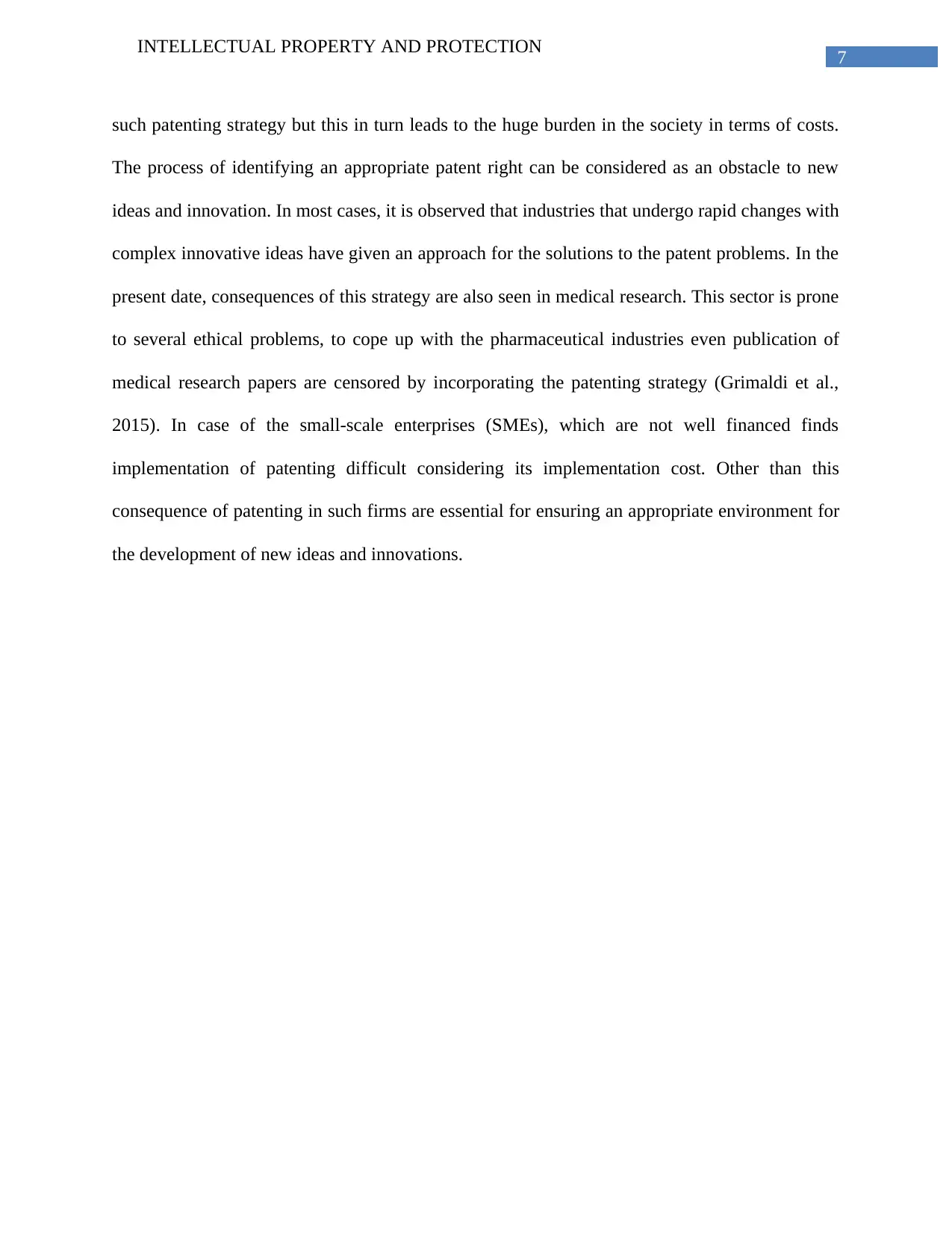
7
INTELLECTUAL PROPERTY AND PROTECTION
such patenting strategy but this in turn leads to the huge burden in the society in terms of costs.
The process of identifying an appropriate patent right can be considered as an obstacle to new
ideas and innovation. In most cases, it is observed that industries that undergo rapid changes with
complex innovative ideas have given an approach for the solutions to the patent problems. In the
present date, consequences of this strategy are also seen in medical research. This sector is prone
to several ethical problems, to cope up with the pharmaceutical industries even publication of
medical research papers are censored by incorporating the patenting strategy (Grimaldi et al.,
2015). In case of the small-scale enterprises (SMEs), which are not well financed finds
implementation of patenting difficult considering its implementation cost. Other than this
consequence of patenting in such firms are essential for ensuring an appropriate environment for
the development of new ideas and innovations.
INTELLECTUAL PROPERTY AND PROTECTION
such patenting strategy but this in turn leads to the huge burden in the society in terms of costs.
The process of identifying an appropriate patent right can be considered as an obstacle to new
ideas and innovation. In most cases, it is observed that industries that undergo rapid changes with
complex innovative ideas have given an approach for the solutions to the patent problems. In the
present date, consequences of this strategy are also seen in medical research. This sector is prone
to several ethical problems, to cope up with the pharmaceutical industries even publication of
medical research papers are censored by incorporating the patenting strategy (Grimaldi et al.,
2015). In case of the small-scale enterprises (SMEs), which are not well financed finds
implementation of patenting difficult considering its implementation cost. Other than this
consequence of patenting in such firms are essential for ensuring an appropriate environment for
the development of new ideas and innovations.
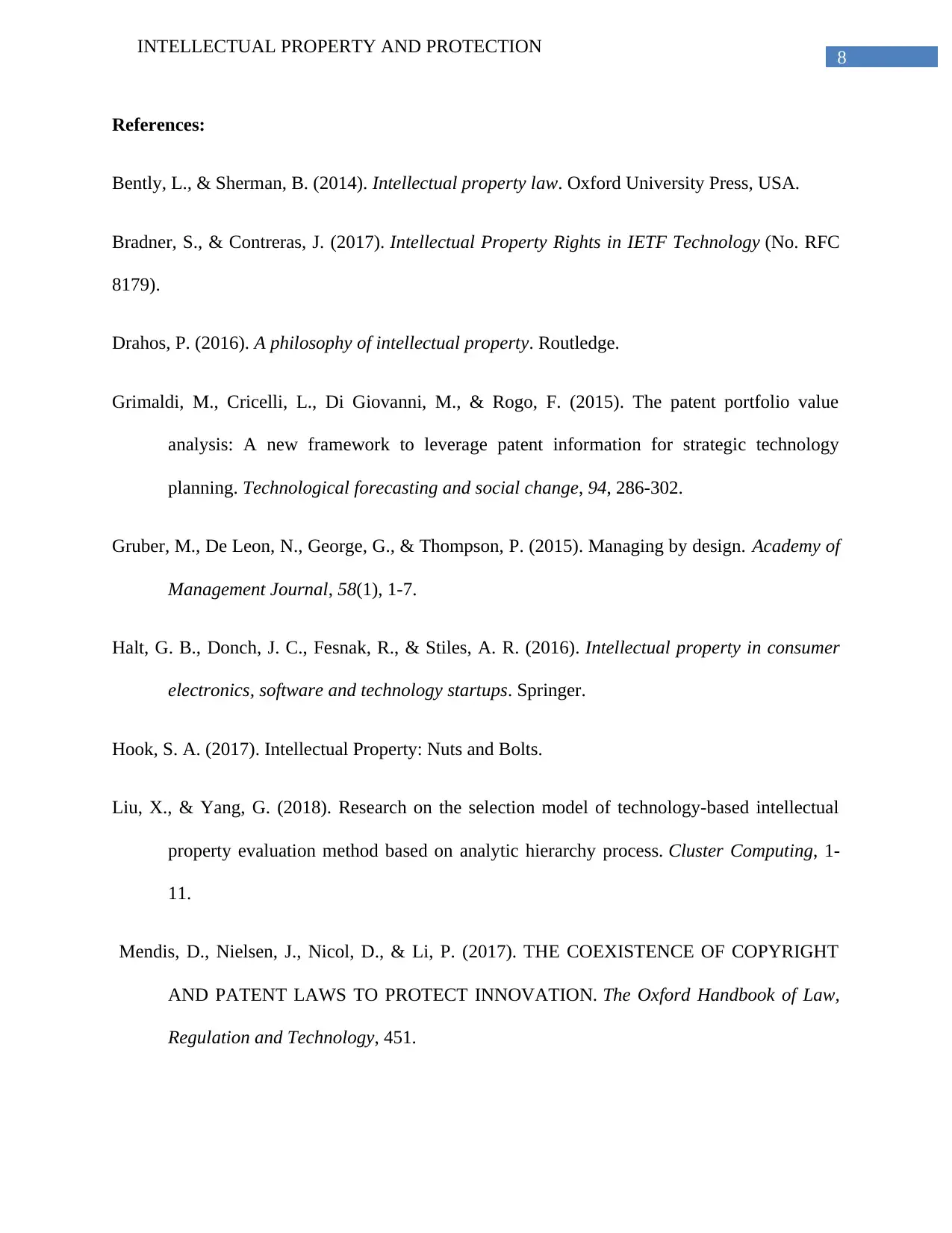
8
INTELLECTUAL PROPERTY AND PROTECTION
References:
Bently, L., & Sherman, B. (2014). Intellectual property law. Oxford University Press, USA.
Bradner, S., & Contreras, J. (2017). Intellectual Property Rights in IETF Technology (No. RFC
8179).
Drahos, P. (2016). A philosophy of intellectual property. Routledge.
Grimaldi, M., Cricelli, L., Di Giovanni, M., & Rogo, F. (2015). The patent portfolio value
analysis: A new framework to leverage patent information for strategic technology
planning. Technological forecasting and social change, 94, 286-302.
Gruber, M., De Leon, N., George, G., & Thompson, P. (2015). Managing by design. Academy of
Management Journal, 58(1), 1-7.
Halt, G. B., Donch, J. C., Fesnak, R., & Stiles, A. R. (2016). Intellectual property in consumer
electronics, software and technology startups. Springer.
Hook, S. A. (2017). Intellectual Property: Nuts and Bolts.
Liu, X., & Yang, G. (2018). Research on the selection model of technology-based intellectual
property evaluation method based on analytic hierarchy process. Cluster Computing, 1-
11.
Mendis, D., Nielsen, J., Nicol, D., & Li, P. (2017). THE COEXISTENCE OF COPYRIGHT
AND PATENT LAWS TO PROTECT INNOVATION. The Oxford Handbook of Law,
Regulation and Technology, 451.
INTELLECTUAL PROPERTY AND PROTECTION
References:
Bently, L., & Sherman, B. (2014). Intellectual property law. Oxford University Press, USA.
Bradner, S., & Contreras, J. (2017). Intellectual Property Rights in IETF Technology (No. RFC
8179).
Drahos, P. (2016). A philosophy of intellectual property. Routledge.
Grimaldi, M., Cricelli, L., Di Giovanni, M., & Rogo, F. (2015). The patent portfolio value
analysis: A new framework to leverage patent information for strategic technology
planning. Technological forecasting and social change, 94, 286-302.
Gruber, M., De Leon, N., George, G., & Thompson, P. (2015). Managing by design. Academy of
Management Journal, 58(1), 1-7.
Halt, G. B., Donch, J. C., Fesnak, R., & Stiles, A. R. (2016). Intellectual property in consumer
electronics, software and technology startups. Springer.
Hook, S. A. (2017). Intellectual Property: Nuts and Bolts.
Liu, X., & Yang, G. (2018). Research on the selection model of technology-based intellectual
property evaluation method based on analytic hierarchy process. Cluster Computing, 1-
11.
Mendis, D., Nielsen, J., Nicol, D., & Li, P. (2017). THE COEXISTENCE OF COPYRIGHT
AND PATENT LAWS TO PROTECT INNOVATION. The Oxford Handbook of Law,
Regulation and Technology, 451.
⊘ This is a preview!⊘
Do you want full access?
Subscribe today to unlock all pages.

Trusted by 1+ million students worldwide
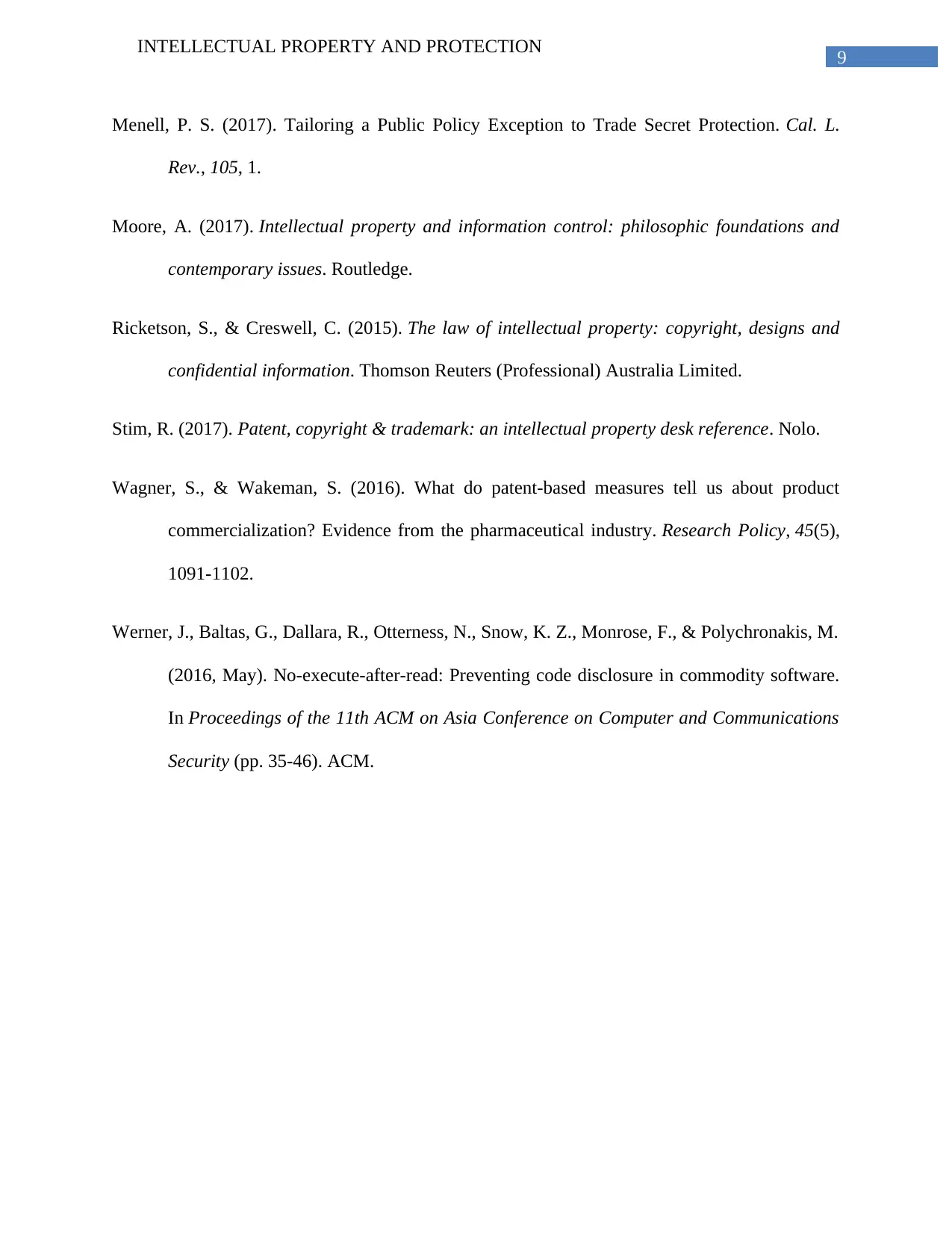
9
INTELLECTUAL PROPERTY AND PROTECTION
Menell, P. S. (2017). Tailoring a Public Policy Exception to Trade Secret Protection. Cal. L.
Rev., 105, 1.
Moore, A. (2017). Intellectual property and information control: philosophic foundations and
contemporary issues. Routledge.
Ricketson, S., & Creswell, C. (2015). The law of intellectual property: copyright, designs and
confidential information. Thomson Reuters (Professional) Australia Limited.
Stim, R. (2017). Patent, copyright & trademark: an intellectual property desk reference. Nolo.
Wagner, S., & Wakeman, S. (2016). What do patent-based measures tell us about product
commercialization? Evidence from the pharmaceutical industry. Research Policy, 45(5),
1091-1102.
Werner, J., Baltas, G., Dallara, R., Otterness, N., Snow, K. Z., Monrose, F., & Polychronakis, M.
(2016, May). No-execute-after-read: Preventing code disclosure in commodity software.
In Proceedings of the 11th ACM on Asia Conference on Computer and Communications
Security (pp. 35-46). ACM.
INTELLECTUAL PROPERTY AND PROTECTION
Menell, P. S. (2017). Tailoring a Public Policy Exception to Trade Secret Protection. Cal. L.
Rev., 105, 1.
Moore, A. (2017). Intellectual property and information control: philosophic foundations and
contemporary issues. Routledge.
Ricketson, S., & Creswell, C. (2015). The law of intellectual property: copyright, designs and
confidential information. Thomson Reuters (Professional) Australia Limited.
Stim, R. (2017). Patent, copyright & trademark: an intellectual property desk reference. Nolo.
Wagner, S., & Wakeman, S. (2016). What do patent-based measures tell us about product
commercialization? Evidence from the pharmaceutical industry. Research Policy, 45(5),
1091-1102.
Werner, J., Baltas, G., Dallara, R., Otterness, N., Snow, K. Z., Monrose, F., & Polychronakis, M.
(2016, May). No-execute-after-read: Preventing code disclosure in commodity software.
In Proceedings of the 11th ACM on Asia Conference on Computer and Communications
Security (pp. 35-46). ACM.
Paraphrase This Document
Need a fresh take? Get an instant paraphrase of this document with our AI Paraphraser

10
INTELLECTUAL PROPERTY AND PROTECTION
INTELLECTUAL PROPERTY AND PROTECTION
1 out of 11
Related Documents
Your All-in-One AI-Powered Toolkit for Academic Success.
+13062052269
info@desklib.com
Available 24*7 on WhatsApp / Email
![[object Object]](/_next/static/media/star-bottom.7253800d.svg)
Unlock your academic potential
Copyright © 2020–2025 A2Z Services. All Rights Reserved. Developed and managed by ZUCOL.





